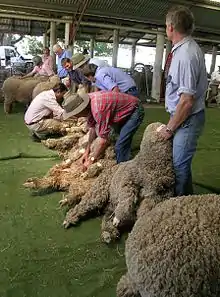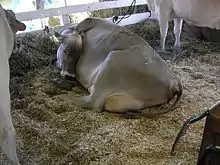Livestock show
A livestock show is an event where livestock are exhibited and judged on certain phenotypical breed traits as specified by their respective breed standard. Species of livestock that may be shown include pigs, cattle, sheep, goats, horses, llamas and alpacas.[1] Poultry such as chickens, geese, ducks, turkeys and pigeons are also shown competitively.[2] A livestock show may be part of an agricultural show.

Showing criteria
The phenotypical traits that are evaluated with all species of livestock are muscle, structural correctness, frame size, style and balance. These certain traits will vary with certain species as well as if the animal is shown for market or for breeding stock. For meat animals, muscling is an important trait. There are several indicators of muscle, mainly being on the top line and rear of the animal. For dairy animals, qualities that improve milk production are vital. For poultry, feathers are important, and traits such as broken or cut feathers are a disqualification. Structural correctness is another trait refers to how well the animals skeleton is put together, more specifically their bone structure.

The animal needs to move with ease and smoothness. Animals should also have proper angles to their pasterns and flex in their joints, should as their hock, knee, and shoulder. Frame is another trait that is looked at when judging livestock. Frame should be decided on whether the animal is long-bodied, tall fronted, and have some internal capacity. An animal that has style and balance is one that holds its head up high when it walks, and is smooth in its overall appearance. The animal should be free of excess fat and should stand with a wide base.
In the unique case of horses, horse shows include not only the conformation judging common to all livestock, but also add performance classes where the animals are either ridden or shown in harness to display their training and underlying athletic ability, manners and temperament.
Pigs
Pigs are exhibited by walking the animal into an arena using a hog driving utensil such as a whip, stock cane or plastic stick. Most of the contestants will carry a brush to clean the animal if it gets dirty while in the arena. The judge will then evaluate each contestant's animal and choose a winner.
Beef Cattle
Cattle are exhibited by leading the animal into an arena using a halter. The contestants in beef showing will also carry a large comb to brush the animal's fur, and a show stick to adjust the animals hoof position to aid in the presentation of the animals posture. The front feet of the animal should always be parallel with one another, and the back feet off set. The foot on the exhibitor's side should be closer, so the judge can see the inside of the leg. After the feet are set the exhibitor uses the show stick to scratch the calf's belly to relax them.
Dairy Cattle Dairy cattle shows differ from beef cattle in many ways. For instance, dairy cattle exhibitors walk backwards. Exhibitors are not allowed to use show sticks, so they must know when to stop their animal, so the feet are set properly.
Sheep
Sheep are exhibited by leading the animal into an arena by hand, as no halter is typically used. Young exhibitors often lead sheep with a halter when they first begin their show career. The contestant will adjust the animal's hooves to best present its posture. When the judge approaches to inspect the animal and possibly feel the animal, it is common for contestants to push into their animals with their bodies to cause the animals to push back against them so the rear muscles of the animal will tighten. The judge may walk in between the animals during a sheep show. Exhibitors must make sure that their sheep is always between them and the judge. The judge can now compare the sheep with the others in the ring easily. The judge will then evaluate each contestant's animal and choose a winner.
Goats
Goats are exhibited by leading the animal into the arena by using a show chain. The contestant will adjust the animal's hooves to best present its posture in a square nature, which helps show off the animals structure and frame. When the judge approaches to inspect the animal and possibly feel the animal, it is common for contestants to push into their animals with their bodies to cause the animals to push back against them so the rear muscles of the animal will tighten. This is called bracing and you only do this too market animals to show the muscles in the back legs and loin. During a goat show the judge may walk between the animals. Exhibitors must make sure that the goat is always between them and the judge. The judge can now compare the goat with the others in the ring easily. The judge will then evaluate each contestant's animal and choose a winner.
Chicken, Turkeys, and Ducks Exhibitors hold their chicken and duck in the crook of their arm, almost like they scooped up the animal. Chickens and ducks are set on a table and are felt for meat quality by the judge. Turkeys are walked in the ring by the exhibitor. Turkey exhibitors grab the feet of the turkey and flip it upside down and support the animal's back on their thigh. The animals are flipped upside down to examine the meat easily, since there isn't much meat on their backs.
Rabbits When showing a rabbit, exhibitors wear a long sleeve white shirt or lab coat, jeans, and boots. Exhibitors put their rabbits in a dual sided cage. The judge then takes the rabbit out of the cage and feels each rabbit for meat quality. They then grab the rabbit by the scruff or the back of the neck to turn the rabbit over to check the meat quality on all sides of the animal.
History
For as long as humans have domesticated animals in order to produce meat, livestock judging has been a critical skill. Butchers – and later, commercial meat packers – had to be able to judge how much meat they could cut out of an animal just by looking at a live animal. Breeders responsible for producing the next generation had to judge how well males would pass on desirable traits and how well females would produce and care for their offspring. Those responsible for raising the animals and feeding them to the point of slaughter had to judge how well the young animals would convert the food that was available into useful meat.
In the 50s and 60s, livestock judging became much more scientific. Also, the standards judges were looking for changed dramatically in response to both consumer and industry demands.
By the 50s, livestock judging was big business. A "Grand Champion" bull or boar or ram or stallion could command top dollar to impregnate females of his species. The progeny of highly judged females would also command top dollar.
To provide a venue for this business, states, cities and commercial enterprises organized what have become elaborate fairs and exhibitions. In 1841, the New York legislature appropriated $8,000 to promote "agriculture and household manufacturers in the State." Other states followed. A central event at each has been the exhibition and judging of the best agricultural products and livestock.
In 1896, the town of Fort Worth, Texas, was trying to lure one of the Big Four meatpacking companies of the day to locate next to their struggling livestock market. So, the market, the railroads that used Fort Worth as a hub, and key ranchers from the surrounding territory came together to produce the Fort Worth Stock Show, the first event dedicated to livestock exhibition and judging alone. Now, it's a three-week extravaganza with a rodeo, shopping, educational events and over 22,000 animals to be judged, including cattle, horses, hogs, sheep, goats, poultry, donkeys, mules, rabbits and llamas.
In the early days, the stock show winners received saddles, boots, hats and other premiums. Later they got cash prizes as well as the advertising value for their animals. But the early organizers recognized that one of the main values of the exhibition was to allow cattle breeders from all over to talk to each other and look at the best of the breeds.
In a 1947 Livestock Judging Handbook, for instance, counseled that judges should downgrade a hog if it "Lacks finish. Not fat enough." "Finish" meant the hog had a firm and ample layer of fat under its skin and especially across a highly rounded back. Judges did not want to see rippling muscles. Instead, in 1947, "a fairly high finish is essential to the production of firm, high quality pork chops" with a good deal of marbling.
Hogs in general were heavier than they are today and carried more fat. There was a specific class of market hogs known as "lard-type barrows." (Barrows are castrated male pigs.) These were hogs specifically sold to produce lard in the days before the popularity of vegetable oils for cooking.
What constituted "best of the breeds" changed dramatically during the 1950s and 1960s. As we've seen, consumer preferences in meat were changing into response to health research. That changed what qualities livestock judges were looking for.
In 1992, the fifth edition of Livestock Judging, Selection and Evaluation, by Roger E. Hunsley, outlined how the ideal hog had changed through the decades –
In the 1940s and early 1950s, the ideal hog was "short, deep, chuffy, excessively fat."
In the late 1950s, the ideal was a "long, narrow, rather meatless hog… This hog was light-muscled and did not grow and attain a high degree of efficiency so essential to the swine industry."
In the 1960s and 1970s, packers pushed growers to supply them with "moderately long, thick, muscular, trim, heavy-boned" hogs that weighed around 220 pounds. Toward the end of this period, producers began using confinement facilities and that changed the ideal again.
In the late 1970s and 1980s, the ideal became the "deep, loose-structured, high-performing, confinement-adaptable hog." The ideal weight went up to 240 pounds as producers wanted animals that could quickly convert feed into meat.
In the 1990s, consumers asserted themselves again, and the ideal became "the ultra-lean, heavy-muscled, wide-bodied, fast-growing, sound-structured, efficient market hog." The ideal market weight went up again to 250 pounds or more.
There have been similar changes in the ideal types of animals being judged in cattle and sheep competitions during this time, as well.
From the 1920s on, government meat standards have been important measures of the quality of meat, particularly with beef. U.S. Prime Grade beef was as good as it gets. During the 60s, supermarkets were looking for ways to attract consumers to their meat counters, and they found that the "Choice" stamp of approval would draw customers in.
United States
There are many different livestock shows all over the United States. Some of the more prestigious livestock shows are; the North American International Livestock Exposition held in Louisville, Kentucky, the American Royal held in Kansas City, Missouri, the National Western Stock Show held in Denver, Colorado, the Houston Livestock Show and Rodeo held in Houston, Texas and the Fort Worth Stock Show and Rodeo held in Fort Worth, Texas. In addition, numerous livestock breeds hold shows for junior exhibitors annually, such as the National Junior Angus Show.
References
- Ekarius, Carol (2008). Storey's Illustrated Breed Guide to Sheep, Goats, Cattle and Pigs. Storey Publishing. ISBN 978-1-60342-036-5.
- Ekarius, Carol (2007). Storey's Illustrated Guide to Poultry Breeds. Storey Publishing. ISBN 978-1-58017-667-5.
3. “Livestock.” Livestock | San Antonio Stock Show & Rodeo, www.sarodeo.com/livestock.
4. Judging Livestock during the 1950s and 60s, livinghistoryfarm.org/farminginthe50s/crops_11.html